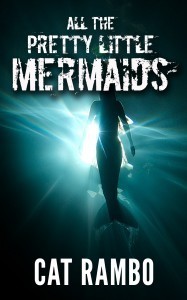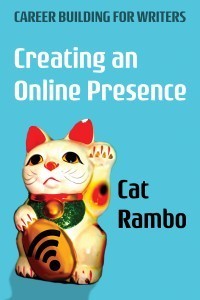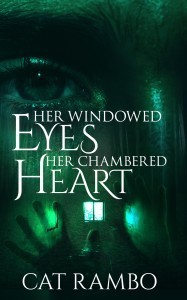Cat Rambo's Blog, page 56
November 26, 2014
The One Twitter List You Should Be Keeping
If this is all that your social media plan consists of, you may want to put more time and thought into it.
Are you a writer on Twitter because you’ve been told you need to be on there? Are you trying to establish “a social media presence” while not quite sure what that involves? Relax and don’t worry. Twitter can be easy and often a lot of fun as well as useful, as long as you take the time to learn some of the basics for Twitter use.One useful tool for making the most of Twitter is the list feature, where you can sort a subset of your followers into their own group. If you’ve never used it, you may want to start by reading through Twitter’s own basic tutorial on lists.
Twitter lists are a great feature that are worth making the most of. I’ve got a few set up for industry professionals, close friends on Twitter, members of various writing groups and organizations, former students, and people in a variety of fields. But there’s one that is more important than any of the others.
Building Your Followers
A pack of followers made up of people who followed you back because you followed them is not a particularly useful list. You want followers who retweet your content, help spread your message, and who provide interesting and useful content that you may want to share in turn. For this reason, it’s worth putting a few minutes each day into maintaining it. I use two tools to help me do this: Buffer and Justunfollow.
Buffer allows me to schedule tweets (which I also like because I can post stuff when not around and find new followers that way). When I initially post a link to a blogpost, for example, I can go ahead and set up a couple of additional mentions further on down the line. More importantly, I use Buffer when doing my daily follower check, looking to see who’s following me that I want to follow back. I look at each new follower’s tweets and usually favorite a couple or find tweets that I want to retweet, sticking them in my Buffer queue. (I should note that I am not using the free version of Buffer but the next version up, which lets me schedule roughly ten days of tweets in advance.
Who I Don’t Follow Back
I don’t follow everyone back automatically. Here’s the list that’s evolved over time of profiles I don’t bother following back:
Sell, sell, sell. Is your stream full of nothing but links to your book on Amazon? Then I’m probably not worrying about.
Nonexistent. No photo, no background info, no tweets? I’m not going to bother.
Promising me social media success. I’m not buying Twitter followers, nor am I paying for expensive seminars that tell me things that are common sense.
Hate speech. That should, I think, go without saying.
Disagree with me politically? That’s fine. I enjoy conversation. Post nothing but silly puns or kitten pictures? I’m fine with that. I’m even good with total nonsense. This sorting stage is where I build a lot of my lists, though not that crucial one I want to talk about. That one comes later.
The Interactives List
Lists are a terrifically useful feature of Twitter, allowing you to create subgroupsand view tweetstreams made up of only tweets from people on that list. Many of my lists are devoted to either a specific group like former students or players of a MUD I used to work with or an industry niche, like book reviewers or editors. And then there’s the most important list of all.
This list is top of my heap and it’s titled Interactives, for people that interact, who RT and reply and generally signal boost. I try to periodically thank people for RTing, which means running through who’s done it recently, and I add people to it at that point. The people on that list have demonstrated that they enjoy my content and want to spread my message. That’s a very good reason for working at building a relationship with them.
When I’m just poking at Twitter, looking to see what interesting conversations are happening or what content is noteworthy or a good candidate for retweeting, I go to that list first. If I’m filling up my Buffer stream with some interesting content, I can find it there, and continue to build the relationship while also giving my followers interesting and/or entertaining content.
If you’re worried about it getting too cluttered, run the tool I mentioned, Justunfollow, periodically to weed out people not following you back and inactives. That should do the trick for all but the most popular of Tweeters.
November 25, 2014
End of the Year Reading Recommendations
Now available on Smashwords, "All the Pretty Little Mermaids," which originally appeared in Asimov's. You set the price! If you enjoy it, please leave a review.
I spent a good chunk of my summer reading through a multi-volume fantasy series for the sake of completeness. The series will remain nameless, because I can’t in good conscience recommend it, but it did impact the amount of other reading I did. Most of these are particular to 2014, but not all.Daniel Abraham came out with the most recent of his Dagger and Coin series, The Widow’s House, and it was just as enjoyable as the first three. Abraham has a gift for flawed characters that you care deeply about, whose dilemmas rack the reader to the heart even when they’re doing despicable things.
Carol Berg’s Dust and Light. Carol consistently hits it out of the ballpark when it comes to epic fantasy, and this start to a trilogy is no exception. If you like Sanderson, Martin, or Bujold’s fantasy, you will like Carol Berg.
The Hole Behind Midnight by Clinton Boomer is terrific urban fantasy with a highly original protagonist. Think of a mash-up of Jim Butcher’s The Dresden Files with the Tyrion Lannister sections of Game of Thrones and Salman Rushdie’s Midnight’s Children and you’re in the general vicinity.
M.L. Brennan manages urban fantasy outside the tired norm with Iron Night, the latest in her Generation V series. I will admit, her kitsune character has me totally captivated, but the vampires manage not to be cliche, and protagonist Fortitude Scott is wonderful, reminding me of Rob Thurman’s engaging Caliban series.
Stephen Brust and Skyler White’s The Incrementalists is urban fantasy taken in a different direction, with an ancient society intent on nudging humanity along in the right directions.
Harry Connolly’s Twenty Palaces series is still more urban fantasy. There’s only four of them, and I wish it were twenty-four. I really enjoy the flavor and wonderful, terrible magic that fills this books. Great stuff.
I reviewed Gardner Dozois and George R.R. Martin’s Dangerous Women for Cascadia Subduction Zone and found it overall satisfying, particularly pieces by Megan Lindholm and Carrie Vaughn.
Caren Gussoff’s The Birthday Problem. Seattle and a plague of madness-inducing nanobots? Sign me up. This is a terrific short novel that should be kept in mind for award ballots.
M.C.A. Hogarth’s The Mindhealer’s Series, Mindtouch and Mindline, were lovely, charming reads about a friendship between two disparate but equally compassionate healers. Looking forward to more in this series. Also recommended: Even the Wingless (looking forward to that serial as well.)
Kameron Hurley’s The Mirror Empire, the first volume of the Worldbreaker Saga. Beautiful fantasy with all sorts of wonderful world-building detail and absolutely gripping characters. Highly recommended, and another to keep in mind for award ballots.
Elliott Kay’s Poor Man’s Fight and Rich Man’s War. I love books with an economic underpinning to them, and this far future military SF delivers wonderfully. Sometimes the villain is almost a little too cartoony, but if you take it as space opera, it’s pretty wonderful.
Meilan Miranda’s Son in Sorrow is the engaging second volume of her An Intimate History of the Greater Kingdom. There’s a level of intrigue and sexuality to these books that reminds one of Jacqueline Carey’s Kushiel books, with equally deft prose and dialogue.
Linda Nagata’s The Red: First Light was terrific military SF/political thriller with lots of engaging detail and a solid dash of cyberpunk. Good stuff, highly recommended.
Tom Perrotta’s The Leftovers is lovely, and significantly better (imo) than the HBO series. It has a wonderful poetry to it that i will match against any lit fic by Paul Auster or T.C. Boyle.
Sofia Samatar’s A Stranger in Olondria was beautiful, reminding me at times of LeGuin’s Earthsea books. Samatar is burning up the charts lately with awards, and this was no exception.
Jeff VanderMeer’s Southern Reach Trilogy is tremendous. Often unsettling, eerie, and always striking, like playing a massive multi-player game where no one else is logged on. Highly recommended, also award ballot material. Wayne read these while we were in Costa Rica and liked them just as much
I also reviewed Jo Walton’s My Real Children and What Makes This Book So Great for CSZ, and really enjoyed the heck out of both, though I know I’ll come back to the second much more than the first. As an inveterate re-reader, it’s highly satisfying to read someone else’s account and analysis of the practice, and I emerged from the book with both a to-read and a to-reread list. WMTBSG is highly, highly recommended for fellow genre re-readers.
Andy Weir’s The Martian was engaging as heck because of its protagonist, who is one of the most likable main characters I have ever encountered. A man is trapped on Mars – will he escape? It’s been done before, but rarely so well.
I greatly enjoyed the first of Django Wexler’s flintlock fantasy, , and the second, The Shadow Throne, was equally enjoyable. Engaging POVs that remain tightly controlled and well-plotted.
If you haven’t read the stories and essays in all three Women Destroy… anthologies, they’re well worth checking out. Christie Yant edited Women Destroy Science Fiction, Ellen Datlow edited Women Destroy Horror, and I edited Women Destroy Fantasy.
November 23, 2014
Video: Literary Techniques for Speculative Fiction Online Class
Here’s another video, this time for the Literary Techniques for Speculative Fiction Online Class. This is my favorite so far.
Discussion and in-class writing exercises designed to introduce a number of techniques to use in your own writing such as foreshadowing, alliteration, rhythmic device, allusion, etc, and ways to test them out in short fiction as well as discussion of when and where to use them.
Twitter Basics and Best Practices for Writers
Why Talk About Twitter Basics and Best Practices?
Cat's first nonfiction book talks about how to set up and maintain an online presence -- without cutting into your writing time.
This year I switched the focus of my social media efforts to Twitter, because it seemed to me Facebook was an increasingly ineffectual way to reach fans. Because of that, I’ve been spending a lot more time looking at the people following me on there as well as thinking about Twitter, its philosophy, and its uses overall.
Why does a writer want to be on Twitter? The reason is more than just “sell books”. It’s often a way to network with existing fans (who will buy more books in the future), cultivate new fans, connect with peers and other industry professionals, to find out industry and writing news and yes, of course, to procrastinate in a thousand different ways.
I used to automatically follow people who followed me but nowadays I spend a few minutes to click through and look at their page and the tweets it contains. I’ve noticed that a lot of people are doing it “wrong,” or at least in a way that ends up detracting from their purpose. Most of these are easy fixes. Here’s some tips for setting up an account on there and as well as for maintaining a presence.
The Basics of Setting up a Twitter Account
If you have never experienced Twitter, it’s basically a way to post short messages. I suggest reading some of these basic tutorials on it. Once you’re ready, create your account, keeping the following things in mind.
A picture’s worth a thousand words. Include both a profile and a background picture. Please don’t just make it the default Twitter “egg”.
Give people a reason to follow you. Tell them who you are, but do it in an interesting way.
Give people a way to find out more. Include your website in your profile.
Remember that profiles include SEO keywords. Think about what sort of searches you want readers to be finding you by and include them (gracefully!) in your bio.
Don’t sell stuff via an overt link in your profile picture, background picture, or bio. It comes off as over-eager and clueless.
Make it look nice. Proofread!
Best Practices on Twitter for Writers
Part of successful social media is consistency. You have to do something on at least a monthly basis, and really probably a bit more often than that unless you’re determined to be as barebones as possible, in which case you might as well just renounce the world electronic and move to the woods to live off the grid. (IMO).
Don’t sell, sell, sell. If your stream is nothing but links to your book on Amazon, I’m not following you back. My rule of thumb is at least four non-selling Tweets to every selling one. Examples of nonselling? Promoting other people’s stuff, cat or child pictures, observations about life, interesting or enlightening quotes, links to articles that interested you, and snippets from your own #wip are all valid.
Don’t be negative. Don’t be jaded or whiney or bitter or angry or mean. Just don’t. Studies show people prefer a positive or cheerful Twitter stream.
Answer and acknowledge. When people RT, my habit is to thank them and also to add them to a special Twitter list. When I’m skimming through Twitter for things to amuse/entertain/idly chatter about/RT, I often look at that list because it’s people who’ve proven they want to build a Twitter relationship.
Be a little selective about your followers. On a daily basis I look to see who’s following me. No profile info? Nothing but book selling? No tweets at all? I don’t follow back. Periodically I run the justunfollow tool and clear my follower list of people I don’t know but am following while they’re not following me back.
It’s okay to repeat yourself (a little). Think that latest blog post was particularly noteworthy? Repeat the announcement the next day, and then again the following week. Build a list of such posts for a “best of” category on your site.
Automate SOME things. Don’t auto-message followers, for example. But do use a tool like Buffer to schedule tweets so you catch a variety of times, such as those repeated posts.
Want to know more about how to use social media and your Internet presence to sell books and find new opportunities without wasting all your time staring at kitten pictures? Sign up for my online class Establishing an Online Presence for Writers on Sunday morning, February 15th, 2015, 9:30 AM-12:30 PM PST. Limited to eight students, who will also receive a free copy of Creating an Online Presence.
November 22, 2014
Video for the Flash Fiction Class
I’ve been having enough fun with the free version of Powtoons that I’m thinking about upgrading. Here’s a video for the flash fiction that I’m 90% happy with. Please like it or share it if you enjoy it.
November 21, 2014
The Inevitable Awards Post, Best of 2014 Version
Found this summer inside a restroom stall in Knoebel's Amusement Park.
Yep, it’s that time of year. Tell me what you thought the best fantasy and science fiction of 2014 was.I’m happy to read people’s stories, novelettes, novellas, and novels with an eye towards finding the best fantasy and science fiction of 2014 and nominating for awards. I try to read/nominate/vote for the following: the Hugos, the Locus Awards, the Million Writers Award, the Nebulas, the Tiptree, and the World Fantasy Award. You can send things to me at catrambo AT gmail.com; I prefer in the body of the email or as an .rtf. Please let me know what categories the piece is eligible for; also please don’t send more than one per category, although you’re welcome to send me a list of the overall year’s output, particularly if you’re Campbell eligible.
If you’re interested in what I produced this year, the stories I am pointing people at are short story, English Muffin, Devotion on the Side, and novelette Rappaccini’s Crow.
Here’s the complete list of everything published in 2014:
FICTION RIVER: PAST CRIMES, edited by Kristine Rusch, December, 2014. The Raiders.
SHATTERED SHIELDS, edited by Jennifer Brozek and Bryan Thomas Schmidt, November, 2014. Hoofsore and Weary.
UNIDENTIFIED FUNNY OBJECTS 3, edited by Alex Shvartsman, November, 2014. Elections at Villa Encantada.
DAILY SCIENCE FICTION, September, 2014. The Moon and the Mouse.
THREE-LOBED BURNING EYE, August, 2014. Eggs of Stone.
BY FAERIE LIGHT, July, 2014. A Brooch of Bone, A Hint of Tooth.
BENEATH CEASELESS SKIES, July, 2014. Rappacini’s Crow.
DAILY SCIENCE FICTION, June, 2014. English Muffin, Devotion on the Side.
SUPERFICIAL FLESH, Spring, 2014. Can You Hear the Moon?.
ASIMOV’S, March, 2014. All the Pretty Little Mermaids.
CLARKESWORLD MAGAZINE, February, 2014. Tortoiseshell Cats Are Not Refundable. Audio version.
STAMPS, VAMPS, AND TRAMPS, edited by Shannon Robinson, 2014. Summer Night in Durham.
Patreon stories included: Her Chambered Eyes, Her Windowed Heart; How Dogs Came to the New Continent; Jaco Tours; Laurel Finch, Laurel Finch, Where Do You Wander?; Mirabai the Twice-lived; The Nondescript Bear; and Prairie Dog Town.
November 16, 2014
Putting Stuff Up
In this steampunk short story, Pinkerton agents Artemus West and Elspeth Sorehs have been chasing their prey across the country. When they finally catch up near the outskirts of the Cascades, though, they find he's gone to ground in a mysterious house that once belonged to his mother, a famous inventor. What secrets hidden in the house will they discover -- and how will the house protect its returned son?
I’ve been putting some stories up on Amazon and Smashwords – I’ve got close to 75 that could go up there, so it’s slow slogging but eventually everything will be up on Amazon, Kobo, and Smashwords. Here’s the categories they fit into:Altered America series: These are steampunk stories, and include Rappaccini’s Crow, which originally appeared on Beneath Ceaseless Skies. Previously unpublished Her Windowed Eyes, Her Chambered Heart is part of that series, and so are two stories that are yet to come: “Laurel Finch, Laurel Finch, Where Do You Wander?” and “Snakes on a Train”. You can see some of the images inspiring the stories here on Pinterest. Currently in progress is “Blue Train,” which takes place in this world although over in a France beleaguered by fairies, vampires, and werewolves.
Tales of Tabat series: These fantasy stories are set in a world I often write in, and so I won’t list all of them. Most have been previously published. Right now the only ones up are “Narrative of a Beast’s Life” and “How Dogs Came to the New Continent.”
Women of Zalanthas: I’ve written a number of stories based on Zalanthas, the world of Armageddon MUD, so I’ve put them together. Right now, stories up include “Aquila’s Ring“, “Karaluvian Fale“, and “Mirabai the Twice-lived“. Others to come include “Besana Kurac” and the title story from Eyes Like Sky and Coal and Moonlight.
The Villa Encantada series: None of these urban fantasy stories are up yet, but there’s a slew of them, primarily horror. Slightly related to them is previously unpublished horror story, “Jaco Tours.”
SF Stories: I haven’t made the SF stories a series because there’s no real link between most of them. Up so far are “Grandmother“, “Tortoiseshell Cats Are Not Refundable“, “Five Ways to Fall in Love on Planet Porcelain,” “Bus Ride to Mars,” and “Elsewhere, Within, Elsewhen.”
Remember that if you want fresh stories from me each month in your mailbox, you can get them via my Patreon campaign.
#sfwapro
September 16, 2014
From Today’s Writing
Working on a dieselpunkish piece, tentatively entitled “The Blue Train.” People may notice I tend to skip around a bit on project. By my guess, I think I’ve got about a dozen pots boiling at any given time, and at least two of those, right now at least, are longer works. I think this one will end up a reasonable length of around 5k, though.
By six PM, his lordship was up and ready to be shaved and dressed. I had sandwiches sent up, something to tide him over till he went out. His haggard eyes were pouched and heavy as though he hadn’t slept.
“Where to tonight?” I asked as I stirred the lather, smelling of bay rum, and spread it over the black shadows on his jawline.
“Jenkins,” he said. “He’s set up some sort of game in his car on the train. Says it will be novel.”
“Novel” is not a word one likes to hear from an older vampire. So often their ideas of novelty involve pain.
“Have the front desk call me a taxi.” He studied his lapels, fingering the wide black expanse, before he held out an arm and I placed his watch, freshly wound, on his wrist. Gold, not silver. A showy piece, but one vampires would appreciate. They like gaudy on other people.
He looked at me. “Do you want to come?”
He hadn’t asked me that before. It wouldn’t be anything new to have me there waiting on him while he gambled, but previously I’d avoided the vampires. They like nonhuman blood more than human and they’re not hesitant about feeding on servants. Would his presence keep me safe?
But there were tired blue shadows under his eyes. He needed backup. He needed a friend there.
His servant would have to do.
It’s been fun, but lots of research in an era I haven’t done much with. Otoh, the point of divergence from our own is almost a century earlier so lots of leeway.
Why SFWA Should (IMO) Admit Self-Published Writers, and Some Thoughts about the Process
Preparing to take on the challenges ahead.
SFWA, at its usual slow lumbering pace, is heading towards answering the question of whether or not the organization should allow self-publishing as a way to qualify for membership. For those unfamiliar with the current requirements, it involves sales to traditional publishing markets: three stories or a single novel advance at a specified rate (current 6 cents per word for stories and a $2000 advance for a novel, from a market listed as a SFWA qualifying market).Do I believe results with self-publishing should qualify someone for SFWA? Yes, absolutely. To me the only question is how to define those results in a way that makes them comparable with the existing criteria.
The Economics of Being an Author
I believe that increasingly a 100% traditional publishing model is not as economically rewarding for most authors as one which combines it with (or may even be restricted to) self-publishing. Some authors will be able to make that approach pay, but the jury’s still out as to which way that trend will go in the future. However, I believe that SFWA members who follow a path restricted to traditional means will at some point be the minority — if they’re not already. Certainly the results of the poll we took show a lot of SFWA members are pursuing one form or another of self-publishing.
Sometimes people mention the self-publishing “bubble,” with the implication that all this newfangled stuff like e-readers is just a fad. I don’t agree. The experience of reading is undergoing a sea change. While physical books aren’t going away anytime soon, e-books are here to stay.
Are the Traditional Gatekeepers That Crucial?
Some of the arguments I’ve seen focus on the importance of the traditional gatekeepers (editors, publishers, and (to a lesser degree) agents) to the qualifying process. The argument falls along the lines that those gatekeepers are necessary because their economic investment in the text is the most acceptable way to certify quality. This argument also tends to be made primarily by editors and publishers.
While it’s true that self-publishing makes the author the sole and obviously biased person to answer the question whether something’s worthy of publication, luckily there are other ways to determine whether or not something is “professional-level” or not: an economic-based criteria that is already in the qualification rules.
To rely entirely on economic criteria is a more than adequate answer. SFWA already has them in place with the definition of minimum advance and per-word dollar amounts. Beyond that, what a publisher deems “good enough to be published” boils down to economic concerns as well: it means that the publisher believes it will make them enough money that an initial financial investment is worthwhile.
I should point out that, beyond the initial investment of time and creative energy, the self-published writer often — usually, in fact — invests financially in their books, in the form of hiring editing and proofing services, cover art, book design, audio production, advertising, etc. This should not be overlooked when considering the “average” self-published writer, who is very much a professional.
But in any case, it’s really the sales that matter. Whether or not readers want to spend money on the words. Asking self-published writers to prove sales comparable to the existing figures is reasonable as well as a simple and intuitive algorithm: the amount of money a traditional sale must make in order to qualify should equal the amount a self-published piece must make.
How we get people to prove sales is an important question. That and the actual criteria are the two most important decisions SFWA will be making.
Answering Objections:
In answer to some of the various objections I’ve seen.
SFWA shouldn’t do this because it will result in public feuds between traditionalists and the self-published.
Well, yes and no. A few diehards and zealots on either side will lock horns. As happens, and has happened on a regular basis since SFWA’s earliest days, there will come Heated Discussions. I believe this is par for this particular course, which is a lumpy, untended one full of straw men trying to play through.
But that group will be fairly small although loudly vocal. Most of us (and I say us because this is the camp I fall into) realize a number of things:
As professional writers who want to make a living at writing, we need to know what options we have with self-publishing.
There is a growing interest in self-publishing among us, as well as a rising number already trying it.
It is an economically viable way of generating income.
I have a stake in this race — right now I’ve been finding my experiment in what is a essentially a form of self-publishing, a Patreon campaign, a reasonable way to self-publish short stories.
SFWA knows it can’t — and shouldn’t try to — please everyone. This step will be controversial no matter what. The best thing SFWA can do is make sure that reasoning behind the decision is sound, that the membership feels it’s gotten enough chance to weigh in, and that the Board is willing to listen to and acknowledge feedback on an ongoing basis.
A mass of unworthy bozos and hobbyist writers will descend on SFWA, tainting its ranks.
SFWA has plenty already. A few more aren’t going to destroy us. Beyond which, this is why there are qualification criteria.
Bozos and hobbyists both seem boogeymen for the most part to me. No matter what the group, there will always be the brash, the socially-inept, the deficient in empathy or manners, the chip-shouldered, the self-appointed prophets and others lacking in basic social graces. They are an unfortunate fact of life in any population, no matter how refined or well-educated. I have no reason to believe the self-published have them in any greater (or lesser) degree than the current membership, or even the general populace of professional speculative fiction writers.
To worry about the somehow unworthy and unprofessional is to ignore the fact that there’s already a few people in the ranks who are there on scant sales or the kindness of a friend who happens to be an editor. Again, I have no reason to believe that for some reason the ranks of self-published have a disproportionate amount of these. There are some very talented and hardworking writers out there depending on self-publishing.
In Conclusion:
I’ve been re-reading Dale Spender’s excellent nonfiction work, Mothers of the Novel, and working on a lengthy essay drawing parallels between it and some of the recent treatment of women in F&SF: BS like “pink” versus “blue” SF (poor women don’t even get a primary color!), reviews scoffing at Ancillary Justice’s gender “gimmick”, and the Truesdale review of Women Destroying Science Fiction (so many of his essays, really) all come readily to mind.
And there’s some overlap there with self-publishing as well, and the way it dismantles one of the structures that’s often worked to reinforce the status quo, which is traditional publishing. Arguments against the horde of unwashed yahoos that will descend upon SFWA often seem to say as much about the speaker’s attitudes towards class as anything else.
So yes. SFWA already has plenty of members working with self-publishing. Allowing professional writers to qualify via self-published sales is a step that’s both overdue and not dangerous to SFWA. The only real danger would lie in a decision to ignore the importance of self-publishing and its impact on professional writers of today.









